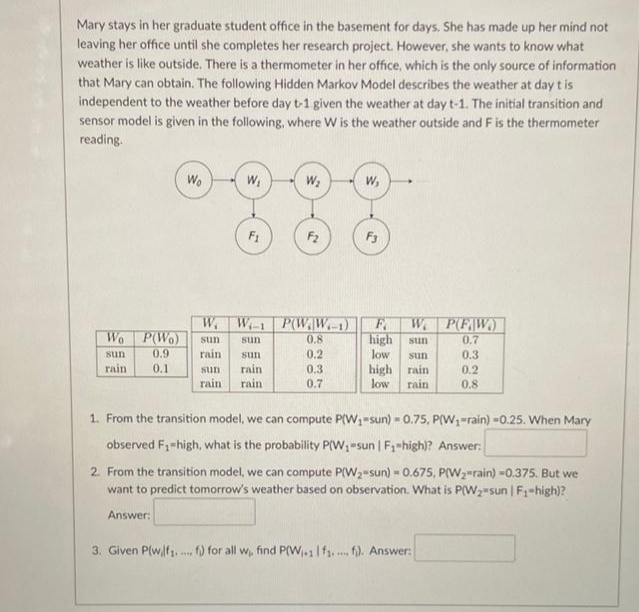Mary stays in her graduate student office in the basement for days. She has made up her mind not leaving her office until she completes her research project. However, she wants to know what weather is like outside. There is a thermometer in her office, which is the only source of information that Mary can obtain. The following Hidden Markov Model describes the weather at day t is independent to the weather before day t-1 given the weather at day t-1. The initial transition and sensor model is given in the following, where W is the weather outside and F is the thermometer reading. We W, W; W, F1 F2 F3 W. Wo P(Wo) We P(WW1) high W P(FW) 0.7 0.3 sun sun 0.8 sun 0.9 rain 0.2 low high rain low sun sun sun rain 0.1 sun rain 0.3 0.2 rain rain 0.7 rain 0.8 1. From the transition model, we can compute P(W;-sun) - 0.75, P(W;-rain) -0.25. When Mary observed F-high, what is the probability P(W; sun | F1•high)? Answer: 2. From the transition model, we can compute P(W2-sun) - 0.675, P(Wzerain) -0.375. But we want to predict tomorrow's weather based on observation. What is P(W2-sun | F;-high)? Answer: 3. Given P(wf. f) for all w, find P(W,|f. f). Answer:
Mary stays in her graduate student office in the basement for days. She has made up her mind not leaving her office until she completes her research project. However, she wants to know what weather is like outside. There is a thermometer in her office, which is the only source of information that Mary can obtain. The following Hidden Markov Model describes the weather at day t is independent to the weather before day t-1 given the weather at day t-1. The initial transition and sensor model is given in the following, where W is the weather outside and F is the thermometer reading. We W, W; W, F1 F2 F3 W. Wo P(Wo) We P(WW1) high W P(FW) 0.7 0.3 sun sun 0.8 sun 0.9 rain 0.2 low high rain low sun sun sun rain 0.1 sun rain 0.3 0.2 rain rain 0.7 rain 0.8 1. From the transition model, we can compute P(W;-sun) - 0.75, P(W;-rain) -0.25. When Mary observed F-high, what is the probability P(W; sun | F1•high)? Answer: 2. From the transition model, we can compute P(W2-sun) - 0.675, P(Wzerain) -0.375. But we want to predict tomorrow's weather based on observation. What is P(W2-sun | F;-high)? Answer: 3. Given P(wf. f) for all w, find P(W,|f. f). Answer:
Elementary Linear Algebra (MindTap Course List)
8th Edition
ISBN:9781305658004
Author:Ron Larson
Publisher:Ron Larson
Chapter2: Matrices
Section2.5: Markov Chain
Problem 49E: Consider the Markov chain whose matrix of transition probabilities P is given in Example 7b. Show...
Related questions
Question

Transcribed Image Text:Mary stays in her graduate student office in the basement for days, She has made up her mind not
leaving her office until she completes her research project. However, she wants to know what
weather is like outside. There is a thermometer in her office, which is the only source of information
that Mary can obtain. The following Hidden Markov Model describes the weather at day t is
independent to the weather before day t-1 given the weather at day t-1. The initial transition and
sensor model is given in the following, where W is the weather outside and F is the thermometer
reading.
Wo
W;
W,
F1
F2
F3
W. W-1 P(WW1)
0.8
F
high
low
We P(FW)
Wo P(Wo)
sun
0.7
sun
sun
0.9
rain
0.2
0.3
sun
sun
sun
0.3
гain
0.1
rain
rain
high rain
sun
0.2
rain
0.7
low
rain
0.8
1. From the transition model, we can compute P(W,-sun) -0.75, P(W,-rain) =0.25. When Mary
observed F1-high, what is the probability P(W sun | F1-high)? Answer:
2. From the transition model, we can compute P(W2-sun) - 0.675, P(W, rain) -0,375. But we
want to predict tomorrow's weather based on observation. What is P(W2-sun | F1-high)?
Answer:
3. Given P(wf1. . f) for all w, find P(W,.1|f1, . f) Answer:
Expert Solution
This question has been solved!
Explore an expertly crafted, step-by-step solution for a thorough understanding of key concepts.
Step by step
Solved in 4 steps with 9 images

Recommended textbooks for you

Elementary Linear Algebra (MindTap Course List)
Algebra
ISBN:
9781305658004
Author:
Ron Larson
Publisher:
Cengage Learning

Linear Algebra: A Modern Introduction
Algebra
ISBN:
9781285463247
Author:
David Poole
Publisher:
Cengage Learning

Elementary Linear Algebra (MindTap Course List)
Algebra
ISBN:
9781305658004
Author:
Ron Larson
Publisher:
Cengage Learning

Linear Algebra: A Modern Introduction
Algebra
ISBN:
9781285463247
Author:
David Poole
Publisher:
Cengage Learning